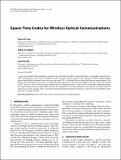Space-Time Codes for Wireless Optical Communications
Author(s)
Haas, Shane M.; Shapiro, Jeffrey H.; Tarokh, Vahid
Download1687-6180-2002-478950.pdf (845.8Kb)
PUBLISHER_CC
Publisher with Creative Commons License
Creative Commons Attribution
Terms of use
Metadata
Show full item recordAbstract
A space-time channel coding technique is presented for overcoming turbulence-induced fading in an atmospheric optical heterodyne communication system that uses multiple transmit and receive apertures. In particular, a design criterion for minimizing the pairwise probability of codeword error in a space-time code (STC) is developed from a central limit theorem approximation. This design criterion maximizes the mean-to-standard-deviation ratio of the received energy difference between codewords. It leads to STCs that are a subset of the previously reported STCs for Rayleigh channels, namely those created from orthogonal designs. This approach also extends to other fading channels with independent, zero-mean path gains. Consequently, for large numbers of transmit and receive antennas, STCs created from orthogonal designs minimize the pairwise codeword error probability for this larger class of fading channels.
Date issued
2002-03Department
Massachusetts Institute of Technology. Laboratory for Information and Decision Systems; Massachusetts Institute of Technology. Research Laboratory of ElectronicsJournal
EURASIP Journal on Applied Signal Processing
Publisher
Hindawi Pub. Corp.
Citation
Haas, Shane M., Jeffrey H. Shapiro, Vahid Tarokh. "Space-Time Codes for Wireless Optical Communications." EURASIP Journal on Advances in Signal Processing. 2002 Mar 18;2002(3):478950.
Version: Author's final manuscript
ISSN
1687-0433
1110-8657